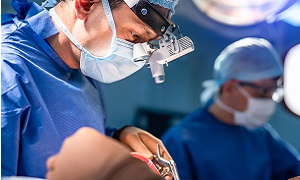Tracheostomy
Tracheostomy is a medical procedure in which the doctor will create a hole in the front of the neck and into the trachea (or windpipe). This is done to place a tracheostomy tube into that opening that stays open for breathing. The tracheostomy tube allows the entry of air into the lungs. The air bypasses the nose, mouth and throat to allow breathing through the tube. The hole in the neck is commonly called a stoma.
Reasons for Tracheostomy
There are various reasons, including airways restriction, because of which people undergo a tracheostomy. Your doctor may perform a tracheostomy, when you have a blocked airway, during an emergency. The procedure is of utmost use when normal breathing becomes difficult because of other diseases or problems. You may have to go for tracheostomy if you have:
- An infection
- The need for a ventilator or respiratory support
- Defects in the airway
- Chronic lung disease
- Underwent facial surgery
- Injury on the chest wall
- Anaphylaxis
- Neck cancer
- Dysfunctioning diaphragm
- Laryngeal injury
- Airway burns due to inhalation of harmful material
- Airway obstruction due to the presence of foreign bodies
- Severe mouth injuries
- Coma
- Facial burns
- Obstructive sleep apnea
- Vocal cord paralysis
- Laryngectomy
- Tumors
- Neck injuries
EMERGENCY CARE
Although most of the surgeons perform this procedure in a hospital setting, they may find it necessary to create the opening in the person’s throat while at the site of the accident, if it is an emergency. Emergency tracheostomies not just carry the risk of complications, they are also difficult to perform.
Preparation for Tracheostomy
What to expect?
During the procedure
Mostly, the doctors perform the procedure in an operating room so that you remain unaware of the entire procedure. He or she will inject local anesthesia (sleep medicine) into your body to numb the throat and the neck. He or she will use local anesthesia if there are visible risks with general anesthesia or if they are performing the procedure outside the operating room. You may opt for:
Surgical Tracheostomy
Surgical Tracheostomy is performed in a hospital room, your surgeon will make a horizontal incision (cut) through your skin in the lower part of the front of the neck. He or she will carefully pull back the surrounding muscles to cut a part of the thyroid gland and expose the trachea or the windpipe. Near the base of your neck, your surgeon will create an opening at a specific spot on your trachea.
Percutaneous Tracheostomy
In the front of the neck, your doctor will make a small incision at the base. He or she will introduce a special lens through the mouth so that they can view the inside portion of your throat. He or she will then guide a needle into the trachea using the view of the throat, to create an opening and will then increase it up to the size of the tube.
After the procedure
You may need to stay back in the hospital as you heal.
- Care for the tube: The nurse will teach you to change or clean your tracheostomy tube so as to prevent any infection and decrease the chances of any risks.
- Speaking: Depending on the type of tube, you will be able to speak with the tracheostomy tube. Your speech therapist or nurse may recommend you some alternatives for communicating and how you can use your voice again to speak.
- Eating: You will receive all the nutrients through an IV (or Intravenous line) inserted in your body or a feeding tube that passes through your nose or mouth. You may also have a tube directly inserted into your stomach. Your speech therapist will work with you when you will be able to eat, to help you with coordination and regain muscle strength needed for swallowing purposes.
- Managing other effects: There are some other effects related to tracheostomy. Your healthcare time will guide you and teach you to care for other common effects. They may teach you to use a suction machine for clearing away the secretions from the airway or your throat.
Results
While tracheostomy is temporary in most of the cases, it may be permanent in some. The procedure provides an alternative breathing route until the medical ailments resolve within your body. If there’s a need for you to be on a ventilator for an indefinite time, this procedure can be the best possible solution.
Your healthcare team will take care of you and determine when you can remove the tracheostomy tube without any chances of complications. The opening will close down after some time and heal on its own. However, your surgeon may also opt to closet the opening surgically.
Risks of Tracheostomy
Any kind of surgery or medical procedure comes with its own risks like bleeding and infection. Although it is rare, you may catch an allergic reaction to the anesthesia (sleep medicine) used for the medical procedure. The risks associated with Tracheostomy are:
- Bleeding
- The thyroid gland, present in the neck, getting damaged
- Lung collapse
- Scar tissue present in the trachea
- Erosion of the trachea (rarely)
- Misplacement of the tracheostomy tube
- Subcutaneous emphysema (trapping of air under the skin on the tissue)
- Pneumothorax (air buildup between the lungs and the chest wall)
- Hematoma or collection of blood that may cause breathing problems.
Long term complications
The longer the tracheostomy, the higher will be the chances of the complications. They may include:
- Damage to the trachea
- Infection around the tracheostomy
- Narrowing of the trachea
- Infection in the bronchial tubules and trachea (Tracheobronchitis)
- Scarring of the trachea
- Infection in the lungs (Pneumonia)
- Obstruction of the tracheostomy tube
- Tracheoinnominate fistula



